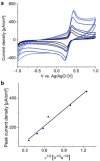2-Methoxyhydroquinone from Vanillin for Aqueous Redox-Flow Batteries
- PMID: 32815619
- PMCID: PMC7891622
- DOI: 10.1002/anie.202008253
2-Methoxyhydroquinone from Vanillin for Aqueous Redox-Flow Batteries
Abstract
We show the synthesis of a redox-active quinone, 2-methoxy-1,4-hydroquinone (MHQ), from a bio-based feedstock and its suitability as electrolyte in aqueous redox flow batteries. We identified semiquinone intermediates at insufficiently low pH and quinoid radicals as responsible for decomposition of MHQ under electrochemical conditions. Both can be avoided and/or stabilized, respectively, using H3 PO4 electrolyte, allowing for reversible cycling in a redox flow battery for hundreds of cycles.
Keywords: lignin; quinone; redox-flow batteries; vanillin.
© 2020 Wiley-VCH GmbH.
Conflict of interest statement
The authors declare no conflict of interest.
Figures



References
-
- E. Commission, A Policy Framework for Climate and Energy in the Period from 2020 to 2030, https://eur-lex.europa.eu/legal-content/EN/TXT/?uri=COM%3A2014%3A15%3AFIN 2020.
-
- E. Commission, A Roadmap for Moving to a Competitive Low Carbon Economy in 2050, http://eur-lex.europa.eu/LexUriServ/LexUriServ.do?uri=COM:2011:0112:FIN:... 2020.
-
- Dunn B., Kamath H., Tarascon J.-M., Science 2011, 334, 928. - PubMed
-
- K. Mongird, V. Fotedar, V. Viswanathan, V. Koritarov, P. Balducci, B. Hadjerioua, J. Alam, Pacific Northwest National Lab and HydroWIRES, Richland, WA, USA, 2019.
-
- Soloveichik G., Chem. Rev. 2015, 115, 11533–11558. - PubMed
Publication types
LinkOut - more resources
Full Text Sources

